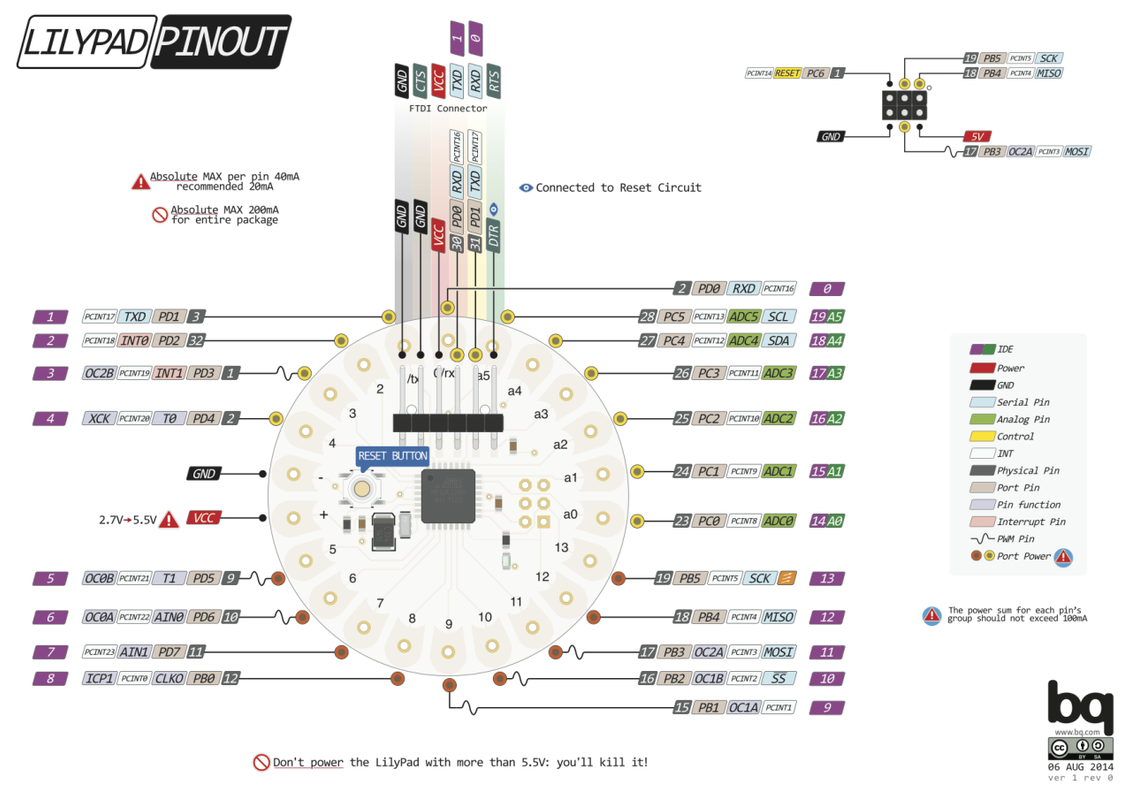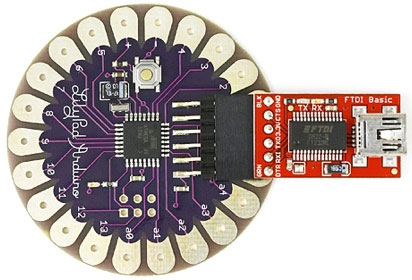AED 50.00
Description
The LilyPad Arduino is a specialized microcontroller board meticulously designed for the realm of wearable technology and electronic textiles. Crafted to seamlessly integrate with fabric through the use of conductive thread, this innovative board offers a unique platform for embedding power supplies, sensors, and actuators into wearable creations. Its versatility lies in its ability to be sewn onto fabrics, opening up a world of possibilities for creative and interactive garments.
Package Includes:
- 1 x LilyPad 328 Main Board ATmega328 16MHz
Features:
- ATmega328 Microcontroller: The LilyPad Arduino features an ATmega328 microcontroller equipped with the Arduino bootloader and a minimal set of external components. This ensures efficient performance and ease of programming.
- Voltage Range: Operating within the range of 2V to 5V, this board provides flexibility in power supply options, accommodating various electronic components seamlessly.
- Automatic Reset Support: To simplify the programming process, the LilyPad Arduino supports automatic reset, enhancing the ease of programming and facilitating a smoother development workflow.
- Flat Back Design: The backside of the LilyPad is meticulously designed to be completely flat, allowing for a snug and inconspicuous fit when attached to fabric, enhancing both comfort and aesthetics.
- ATmega328 at 16 MHz: This version of the LilyPad utilizes the new ATmega328 running at 16 MHz, ensuring optimal performance. The setting for this new LilyPad 328 is recommended for users seeking the latest features and capabilities.
- Material: Crafted from a combination of plastic and metal, the LilyPad Arduino strikes a balance between durability and weight, making it suitable for a wide range of wearable applications.
- Compact Size: With dimensions of Approx. 50x50x3mm / 1.97x1.97x1.12 inch, the LilyPad Arduino offers a compact form factor, ideal for seamlessly integrating into garments without compromising on design.
Description:
In the ever-evolving landscape of wearable technology and electronic textiles, the LilyPad Arduino emerges as a meticulously crafted microcontroller board, purpose-built for innovation. Its specialized design is a testament to the intersection of technology and fashion, providing a distinctive platform for seamless integration with fabric through the ingenious use of conductive thread. Beyond mere functionality, this board serves as a creative canvas, empowering designers to embed power supplies, sensors, and actuators directly into wearable creations. What sets the LilyPad Arduino apart is its remarkable versatility. Designed to be sewn directly onto fabrics, it transforms clothing into interactive canvases for technological expression. This unique integration method opens up boundless possibilities for creators, allowing them to blend technology seamlessly with fashion, giving rise to a new frontier of interactive and dynamic garments. The board boasts a spectrum of innovative features, starting with its core — an ATmega328 microcontroller with the Arduino bootloader. Operating within the voltage range of 2V to 5V, it provides flexibility in power supply options, ensuring compatibility with various electronic components. The support for automatic reset streamlines the programming process, enhancing the user experience. Not just a powerhouse of technology, the LilyPad Arduino pays attention to aesthetics. The backside is ingeniously designed to be completely flat, ensuring a snug fit against fabric without compromising comfort or style. Crafted from a blend of plastic and metal, it strikes the perfect balance between durability and weight, making it an ideal choice for wearable applications. The LilyPad Arduino is powered by the ATmega328 at 16 MHz, guaranteeing optimal performance. With 14 digital I/O pins (including 6 PWM outputs) and 6 analog input pins, it offers a robust interface for connecting various components. The board's compact size, approximately 50503mm, further enhances its adaptability, allowing it to seamlessly integrate into garments without overshadowing the design.
Principle of Work:
The LilyPad Arduino operates internally through its core component, the ATmega328 microcontroller. This microcontroller acts as the brain of the board, executing instructions and managing various functions. When programmed using the Arduino software, the microcontroller interprets the code and executes the specified tasks. The bootloader, pre-burned onto the ATmega328, facilitates the easy uploading of new code through the Arduino software. The board is designed to run on a voltage range of 2V to 5V, providing flexibility in power supply options. It supports automatic reset, simplifying the programming process, and includes 14 digital I/O pins (with 6 offering PWM output) and 6 analog input pins for connecting to sensors, actuators, and other electronic components. The LilyPad's clock speed of 16 MHz ensures efficient and responsive performance. Internally, the LilyPad Arduino manages the flow of data and signals, facilitating communication between the microcontroller and connected devices. The In-Circuit Serial Programming (ICSP) header allows for programming the ATmega328 directly, bypassing the bootloader when needed.
Wearable Applications:
The LilyPad Arduino is specifically designed for integration into wearable projects, providing a unique platform for the convergence of technology and fashion. Its form factor, flat back design, and compatibility with conductive thread make it ideal for sewing onto fabrics:
- Sensor Integration: Connect sensors, such as accelerometers or heart rate monitors, to the LilyPad Arduino to gather data from the user or the environment.
- Actuator Control: Use the board to control actuators like LEDs or motors embedded in clothing, creating dynamic and interactive wearables.
- Power Supply Integration: integrate power supplies into garments, ensuring a discreet and comfortable power source for the LilyPad and connected components.
- Data Processing: Process data collected from sensors on the LilyPad, enabling the creation of responsive and adaptive wearable technology.
- Interactive Garments: Leverage the LilyPad's ability to be sewn onto fabrics to design garments that respond to touch, movement, or environmental conditions, adding an interactive layer to fashion.
- Educational Projects: The LilyPad Arduino serves as an excellent educational tool for teaching electronics and programming in a hands-on, creative manner, making it accessible to students and enthusiasts alike.
Pinout of the Module:

| Pin | Function | Description |
|---|---|---|
| D2 to D13 | Digital I/O Pins | General-purpose digital input or output pins. D3, D5, D6, D9, D10, and D11 support PWM output. |
| A0 to A5 | Analog Input Pins | Analog input pins for connecting sensors or other analog devices. |
| VCC | Power Supply | Power supply pin (2V to 5V). |
| GND | Ground | Ground pin. |
| RX | Receive (Serial Communication) | Receive pin for serial communication. |
| TX | Transmit (Serial Communication) | Transmit pin for serial communication. |
| ICSP Header | In-Circuit Serial Programming | Header for programming the ATmega328 through an external programmer. |
| RESET | Reset | Reset pin for restarting the microcontroller. |
Applications:
-
Wearable Electronics:
- Smart Clothing: Integrate LilyPad into clothing to create smart garments capable of sensing and responding to environmental conditions or user input.
- Interactive Accessories: Develop accessories like hats, bags, or jewelry with embedded sensors and LEDs for interactive and personalized experiences.
-
Health and Fitness:
- Biometric Monitoring: Use sensors to monitor physiological data, such as heart rate or body temperature, in real-time for health and fitness applications.
- Activity Trackers: Create wearable devices that track and analyze user movement and activity levels.
-
Education:
- Electronics Education: Serve as an educational tool to teach electronics and programming in a hands-on and creative manner, making it accessible to students and enthusiasts.
-
Art and Fashion:
- Electronic Art Installations: Incorporate LilyPad into artistic projects, enabling interactive and dynamic electronic art installations.
- Fashion Tech Shows: Design garments for fashion tech shows, blending technology and fashion on the runway.
-
Prototyping and Testing:
- Rapid Prototyping: Facilitate rapid prototyping of wearable devices, allowing designers and developers to quickly test and iterate their ideas.
- Proof of Concept: Use LilyPad for proof-of-concept demonstrations in research and development projects.
-
Accessibility:
- Assistive Technology: Develop wearable devices to assist individuals with specific needs, such as sensory feedback for the visually impaired.
-
Entertainment:
- Costume Design: Enhance costumes for performances, events, or cosplay with lighting effects and interactive elements controlled by LilyPad.
- Wearable Tech Performances: Create performances where artists wear LilyPad-enabled garments that respond to music or audience interactions.
-
Embedded Systems:
- Remote Sensing: Deploy LilyPad in applications where remote sensing and data collection are required, such as environmental monitoring or research projects.
-
DIY Projects:
- Hobbyist Projects: Engage in DIY electronics and programming projects, combining creativity and technology to build unique wearable gadgets.
Circuit:

The best way to program the Lilyopad is using the FTDI programer or compatible which you can find on our website.
Library:
No library is needed for the board to work.
- Open the Arduino IDE.
- Ensure that the correct LilyPad board is selected. Go to "Tools" > "Board" and choose "LilyPad Arduino w/ ATmega328p."
- Select the COM port to which your LilyPad Arduino is connected. Go to "Tools" > "Port" and choose the appropriate COM port.
- Copy and paste the provided code into a new sketch.
- Save the sketch by clicking "File" > "Save" and provide a name (e.g., Blink_LilyPad_ATmega328p).
- Click the right-arrow "Upload" button to compile and upload the code to the LilyPad Arduino.
Code:
The LED on pin 13 should start blinking. If you have an external LED connected to a different pin, make sure to update the ledPin variable in the code accordingly:
// Blinking LED on LilyPad Arduino with ATmega328p
int ledPin = 13; // Pin number for the LED on LilyPad
void setup() {
pinMode(ledPin, OUTPUT); // Set the LED pin as an output
}
void loop() {
digitalWrite(ledPin, HIGH); // Turn on the LED
delay(1000); // Wait for 1 second
digitalWrite(ledPin, LOW); // Turn off the LED
delay(1000); // Wait for 1 second
}
Technical Details:
- Voltage: Supports both 3.3V and 5V operation
- Microcontroller: ATmega328V
- Operating Voltage: 2.7-5.5 V
- Input Voltage: 2.7-5.5 V
- Digital I/O Pins: 14 (6 providing PWM output)
- Analog Input Pins: 6
- DC Current per I/O Pin: 40 mA
- Flash Memory: 16 KB (2 KB used by bootloader)
- SRAM: 1 KB
- EEPROM: 512 bytes
- Clock Speed: 16 MHz
Resources:
Comparisons:
When we compare the LilyPad Arduino and Arduino Uno, the LilyPad Arduino is specialized for wearable applications, featuring a unique design that allows for easy integration into clothing. On the other hand, the Arduino Uno is a versatile, general-purpose microcontroller board suitable for a wide range of electronics projects, including prototyping and education:
1. Form Factor and Design:
- LilyPad Arduino:
- Designed for wearables and e-textiles.
- Flat and circular form factor.
- Sewable with conductive thread.
- Arduino Uno:
- Standard rectangular form factor.
- Not designed for wearables.
- PCB layout suitable for prototyping on a desk.
2. Microcontroller:
- LilyPad Arduino:
- Typically uses ATmega328V or similar.
- Suited for low-power wearable applications.
- Arduino Uno:
- ATmega328P microcontroller.
- General purpose, suitable for a wide range of projects.
3. Power Supply:
- LilyPad Arduino:
- Typically runs on a lower voltage (2V to 5V).
- Suited for battery-powered wearables.
- Arduino Uno:
- Runs on 5V.
- Suited for a wider range of electronic projects.
4. Connectivity:
- LilyPad Arduino:
- Limited digital and analog pins for wearables.
- Designed for specific use cases.
- Arduino Uno:
- Extensive digital and analog pins for general-purpose projects.
- Versatile for various applications.
5. Programming and IDE:
- LilyPad Arduino:
- Compatible with the Arduino IDE.
- Supports Arduino programming language.
- Arduino Uno:
- Standard Arduino programming environment.
- Extensive community support and libraries.
6. Applications:
- LilyPad Arduino:
- Wearable technology and e-textiles.
- Smart clothing and accessories.
- Fashion tech and interactive art.
- Arduino Uno:
- General electronics projects.
- Prototyping and experimentation.
- Educational projects.
7. Special Features:
- LilyPad Arduino:
- Sewable design with conductive thread.
- Flat back for comfortable wear.
- Specialized for wearables and textiles.
- Arduino Uno:
- Breadboard-friendly design.
- Extensive I/O for various applications.
- Standard form factor for compatibility.